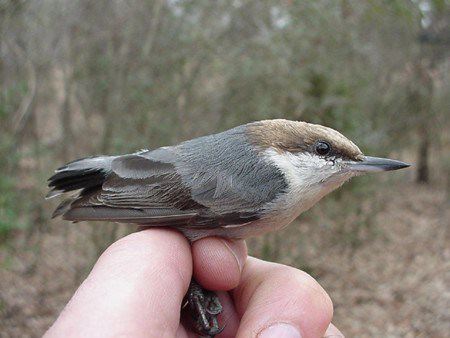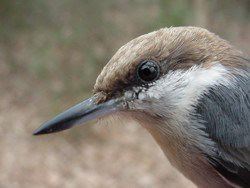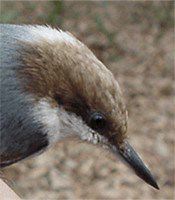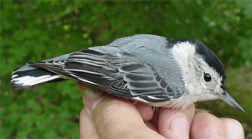|
|
|||
|
THIS WEEK at HILTON POND Subscribe for free to our award-winning nature newsletter (Back to Preceding Week; on to Next Week) |
All text, maps, charts & photos © Hilton Pond Center "Stubby-tailed Squeaky Toy" If you guessed Brown-headed Nuthatch (Sitta pusilla) from the clues on the preceding page, you're absolutely right and deserve a hearty pat on the back. And if you've ever seen and heard one of these diminutive bark gleaners, you'll likely agree that "Stubby-tailed Squeaky Toy" could be an alternative name! Brown-headed Nuthatches (BHNU) are locally common in southern coastal states, especially in Lowcountry pine stands. Somewhat less common in the Piedmont, they are nearly absent from the Carolina mountains except for notable colonies in and around Asheville. Here at Hilton Pond Center, only 31 of them have been captured in 19 years of banding; this week's bird was the first since 1995--the year a neighboring 60-acre pine plantation was clear-cut. We're always excited to see--much less capture and band--a Brown-headed Nuthatch.
In summer, several BHNU pairs may nest in fairly close proximity, and offspring from the previous year are known to help their parents with the current year's nestlings. The nest is typically in a rotten snag anywhere from a few inches to 60 feet from the ground, but that same bluebird box at Hilton Pond that served as a winter roost also produced a batch of baby nuthatches during the breeding season. Two other nuthatches can be found in the Carolina Piedmont. The White-breasted Nuthatch (below left) occurs year-round in deciduous woodlands throughout the Carolinas; its black or gray-black cap, white face and breast, and seemingly large black eye help identify it. Red-breasted Nuthatches (below right), which breed primarily in southern Canada and down the Appalachians into North Carolina, are in the Piedmont only in winter, and not usually in high numbers; their alternating white and black eye stripes and rufous bellies are distinctive. Only six Red-breasted and five White-breasted Nuthatches have been captured at Hilton Pond Center since banding began in 1982.
All text, maps, charts & photos © Hilton Pond Center All three nuthatch species visit bird feeders and pay particular attention to suet and black sunflower seeds. The Brown-headed Nuthatch is unusual among birds in that it has been observed handling a "tool" while feeding: it sometime holds a piece of bark in its bill and uses it to flick other pieces of bark from tree branches and trunks. Although Brown-headed Nuthatches make various vocalizations, one of their calls really does sound like a baby's "squeaky toy." All text, maps, charts & photos © Hilton Pond Center
Checks also can be sent to Hilton Pond Center at: All contributions are tax-deductible on your |
|||


 Nuthatches--with their long, straight, chisel-like bills (right) --are sometimes confused with woodpeckers. They do occasionally hammer in woodpecker-style to dislodge insects, but never with the continuous barrage that woodpeckers use. In addition, woodpeckers forage in a heads-up posture, while nuthatches are noted for moving down a tree trunk or branch head-first. This behavior may give them first shot at insects that are in upward-facing bark crevices. Nuthatches can cling to almost any rough surface; their short legs have long toes with sharp decurved claws.
Nuthatches--with their long, straight, chisel-like bills (right) --are sometimes confused with woodpeckers. They do occasionally hammer in woodpecker-style to dislodge insects, but never with the continuous barrage that woodpeckers use. In addition, woodpeckers forage in a heads-up posture, while nuthatches are noted for moving down a tree trunk or branch head-first. This behavior may give them first shot at insects that are in upward-facing bark crevices. Nuthatches can cling to almost any rough surface; their short legs have long toes with sharp decurved claws. In winter, Brown-headed Nuthatches often flock together, sometimes with other small birds such as chickadees, titmice, Pine Warblers, and Downy Woodpeckers. One January at dusk we were surprised at Hilton Pond Center when a dozen Brown-headed Nuthatches burst from a bluebird box.
In winter, Brown-headed Nuthatches often flock together, sometimes with other small birds such as chickadees, titmice, Pine Warblers, and Downy Woodpeckers. One January at dusk we were surprised at Hilton Pond Center when a dozen Brown-headed Nuthatches burst from a bluebird box.




